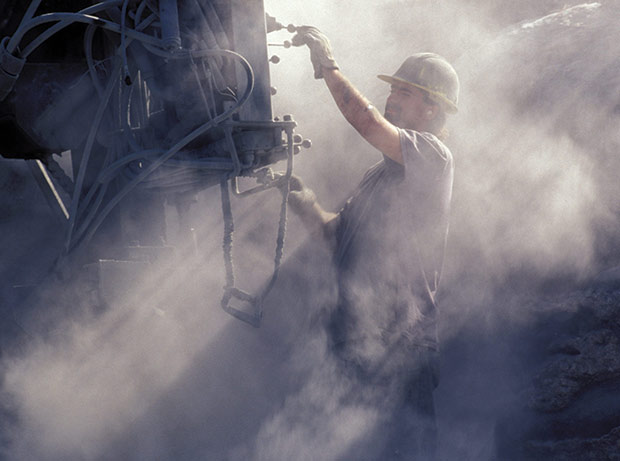New OSHA silica rules set to fall heavily on contractors
By: WISCONSIN LAW JOURNAL STAFF//March 29, 2016//
New OSHA silica rules set to fall heavily on contractors
By: WISCONSIN LAW JOURNAL STAFF//March 29, 2016//

By Buck Sweeney and Micheal Hahn
Axley Brynelson, LLP

The Occupational Safety and Health Administration is in the final stages of drafting new rules regarding employee exposure to silica in the workplace.
The proposed rule, which was first brought up almost three years ago, would set a uniform standard for exposure to the respirable silica dust found in both construction and general industry. It would also cut the permissible-exposure limit by 80 percent for the construction industry, and impose a host of new engineering and work-practice controls on employers.
The federal government has been concerned about silica exposure in the workplace since at least the 1930s, when the Department of Labor first published a report on the dangers of silicosis, a respiratory disease caused by exposure to respirable silica dust. The current permissible-exposure limits for respirable silica dust have been in effect since 1971, the first year OSHA was in existence.
In its notice of proposed rulemaking in 2013, OSHA found that respirable silica dust is a carcinogen and is linked to lung and other cancers, as well as non-malignant respiratory diseases such as emphysema, COPD, and chronic bronchitis. As part of OSHA’s risk assessment, the agency determined that exposure to respirable silica dust at the current permissible-exposure limit for general industry – which is set at 100 µg/m3, for 45 years – would lead to a “significant risk” of adverse health effects.
As a result of OSHA’s review of the health effects of exposure to respirable silica dust, and its risk assessment, the agency proposed a new limit for all industries of 50 µg/m3. In reaching this standard, OSHA determined that this was the lowest limit that was technologically and economically feasible.
While some industry groups, such as the National Industrial Sand Association, have argued that the current permissible-exposure limit is effective at protecting worker safety, it is unlikely that OSHA will alter the final limit of 50 µg/m3. As part of its risk assessment, OSHA found that even exposure at 25 μg/m3 would pose a significant risk to worker health, but it would not be feasible to set the limit at that level. Given this conclusion, OSHA will most likely stand firm on the new 50 μg/m3 limit.
The proposed permissible-exposure limit is half the current one for general industry and only 20 percent of the one currently in place for construction. Reducing employee exposure to respirable silica dust by these levels will require extensive changes in how construction companies operate. To meet the new standards, companies will have to invest resources in equipment and safety programs.
The proposed rule covers much more than just a new permissible-exposure limit. The proposed rule also lays out very specific criteria on how construction companies are supposed to comply.
The first step is to conduct initial monitoring of any employee “who may reasonably be expected to be exposed” to respirable silica dust at the action level. The action level is a lower threshold of 25 μg/m3 of respirable silica dust.
The results of the monitoring determine how the employer needs to respond under the rule. Even if the levels are below the permissible-exposure limits, but above the action level, the employer will need to continue periodic monitoring to ensure that employees have not been exposed to an unacceptable amount of respirable silica dust.

If the monitoring results show that employees are exposed to respirable silica dust above 50 μg/m3, the rule sets out some very specific compliance methods. The first step under the proposed rule is to install engineering controls to limit an employee’s exposure.
These include local exhaust vacuums that capture respirable silica dust and filter out harmful particles. Other engineering controls include improving cabs on large equipment, which can provide a better seal; air conditioning; and HEPA filters to remove any respirable silica dust.
If the engineering controls are insufficient to reduce employee exposure below the limits, the proposed rule requires the use of work-practice controls that alter how employees perform their jobs. The most common work-practice control recommended by OSHA is to use “wet methods” that will help reduce the amount of dust in the air. This will often mean applying water to the source of dust in order to prevent it from becoming airborne.
Only if both engineering controls and work-practice controls are not enough to reduce exposure below the permissible-exposure limits, then OSHA will require employees to use respirators. If respirators are needed, the equipment must be properly fitted for the employees who will use them, and those employees must also undergo medical surveillance to ensure that they do not suffer any adverse health effects. The specific requirements are laid out in the proposed rule.
The final rule is expected to be published any day now. The Office of Management and Budget at the White House is currently reviewing the final rule, and this is the last step in the rulemaking process. The rule becomes effective 60 days after publication, and all “obligations” under the rule are mandatory 180 days after the rule is in effect. However, the engineering controls are not required to be in place for a year.
Construction companies should watch for the final publication in the next few weeks or months. With such a drastic change to the standard, OSHA will definitely be putting an emphasis on enforcement. But if companies take steps now to comply, they won’t have anything to worry about.
Legal News
- Wisconsin attorney loses law license, ordered to pay $16K fine
- Former Wisconsin police officer charged with 5 bestiality felony counts
- Judge reject’s Trump’s bid for a new trial in $83.3 million E. Jean Carroll defamation case
- Dozens of deaths reveal risks of injecting sedatives into people restrained by police
- The Latest: Supreme Court arguments conclude in Trump immunity case
- Net neutrality restored as FCC votes to regulate internet providers
- Wisconsin Attorney General asks Congress to expand reproductive health services
- Attorney General Kaul releases update at three-year anniversary of clergy and faith leader abuse initiative
- State Bar leaders remain deeply divided over special purpose trust
- Former Wisconsin college chancellor fired over porn career is fighting to keep his faculty post
- Pecker says he pledged to be Trump campaign’s ‘eyes and ears’ during 2016 race
- A conservative quest to limit diversity programs gains momentum in states
WLJ People
- Power 30 Personal Injury Attorneys – Russell Nicolet
- Power 30 Personal Injury Attorneys – Benjamin Nicolet
- Power 30 Personal Injury Attorneys – Dustin T. Woehl
- Power 30 Personal Injury Attorneys – Katherine Metzger
- Power 30 Personal Injury Attorneys – Joseph Ryan
- Power 30 Personal Injury Attorneys – James M. Ryan
- Power 30 Personal Injury Attorneys – Dana Wachs
- Power 30 Personal Injury Attorneys – Mark L. Thomsen
- Power 30 Personal Injury Attorneys – Matthew Lein
- Power 30 Personal Injury Attorneys – Jeffrey A. Pitman
- Power 30 Personal Injury Attorneys – William Pemberton
- Power 30 Personal Injury Attorneys – Howard S. Sicula







